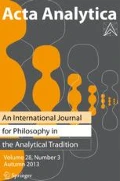Abstract
It is sometimes argued that there is an analogy between time and modality: What is true of time, mutatis mutandis, should be true of modality, and vice versa. However, I think that the importance of this analogy has not been truly appreciated in the literature. In this paper, I try to offer a plausible account of the relationship between time and modality based on what is known as presentist ersatzism. If the attempt succeeds, it will be shown that ersatzists about time are better able to explain what possible worlds are.
Similar content being viewed by others
Notes
An anonymous referee of this journal calls my attention to the recent work by Rasmussen (2015: fn. 9). It should be noted that although his framework is similar to mine, there is a remarkable gap between our positions. Whereas Rasmussen has proposed a presentist approach to ersatz possible worlds by way of defending his Tenseless Presentism, I am inclined to accept tense primitivism (at least primitive actuality and presentness) in my theory and more serious about giving a uniform account of time and modality rather than arguing by analogy. I will clarify some merits of the theory in detail through Section 4.
There may be another merit in taking a possible world as an ersatz B-series. If an ersatz possible world is to describe the world fully, it may be argued that it should also include all abstract representations of what might have been (i.e. other possible worlds). As Lewis says, ‘[i]t is as if we had a library, and every book in the library describes fully … every book in the library’, but ‘[b]ooks being the finite things they are, of course that is impossible’ (1986: 151). In response, ersatzists might say that each possible world only represents how concrete things (including the world as a concrete object) might have been but nothing else, so that the alleged problem will not occur in their theory. Under the approach that I propose here, we can deal with the issue more naturally. It is the nature of an abstract time that it only represents how concrete things (including the concrete world) are at that time but nothing else. Thus, an ersatz B-series constructed out of those times does not include other times or B-series. In short, an ersatz B-series (i.e. a possible world) is a complete series if and only if it represents how concrete things were, are and will be but nothing else. I thank the reviewer for raising this issue.
It may seem that my proposal implies that there is no possible world without time, but this implication will seem costly to those who think that there could be a world without change or time. I respond to this objection in the following way. First, an ersatz B-series constructed out of just one time may count as a possible world even though it sounds strange to call it a series. An instantaneous world is the limit case where the series has a single member, and my proposal should allow such a case if it is in fact logically possible. (I do not think that a possible present must stand in a temporal relation to some other time by its nature.) Second, there is a way for ersatzists about time to deal with the possibility of time without change that have been discussed since Shoemaker (1969) although it is still highly controversial whether one should really accept such a possibility. See Bourne (2006: 66–8). Alternatively, if only multiplicity matters, one could simply distinguish one and the same set of propositions by pairing it with infinitely many integers.
References
Bigelow, J. (1991). Worlds enough for time. Noûs, 25, 1–19.
Bourne, C. (2006). A future for presentism. Oxford: Clarendon.
Cresswell MJ, Rini AA (2012) The world-time parallel. Cambridge University Press
Crisp, T. M. (2007). Presentism and the grounding objection. Noûs, 41, 90–109.
Lewis D (1973) Counterfactuals. Blackwell Publishers
Lewis, D. (1976). The paradoxes of time travel. Am Philos Q, 13, 145–52.
Lewis, D. (1986). On the plurality of worlds. Oxford: Blackwell.
Meyer, U. (2005). The presentist’s dilemma. Philos Stud, 122, 213–25.
Meyer, U. (2013). The nature of time. Oxford: Clarendon.
Parsons, J. (2003). A-theory for tense logicians. Analysis, 63, 4–6.
Rasmussen, J. (2012). Presentists may say goodbye to A-properties. Analysis, 72, 270–76.
Rasmussen J (2015) Tenseless times. Philosophical studies (Published Online): http://link.springer.com/article/10.1007%2Fs11098-015-0466-5?
Shoemaker, S. (1969). Time without change. J Philos, 66, 363–81.
Tallant, J. (2012). (Existence) Presentism and the A-theory. Analysis, 72, 673–681.
Acknowledgments
The first draft of this paper was presented in the Workshop on David Lewis’s On the Plurality of Worlds on March 7th, 2015. I thank my audience for their helpful comments. I am grateful to Seahwa Kim for her excellent suggestions.
Author information
Authors and Affiliations
Corresponding author
Rights and permissions
About this article
Cite this article
Sakon, T. A Presentist Approach to (Ersatz) Possible Worlds. Acta Anal 31, 169–177 (2016). https://doi.org/10.1007/s12136-015-0271-y
Received:
Accepted:
Published:
Issue Date:
DOI: https://doi.org/10.1007/s12136-015-0271-y



